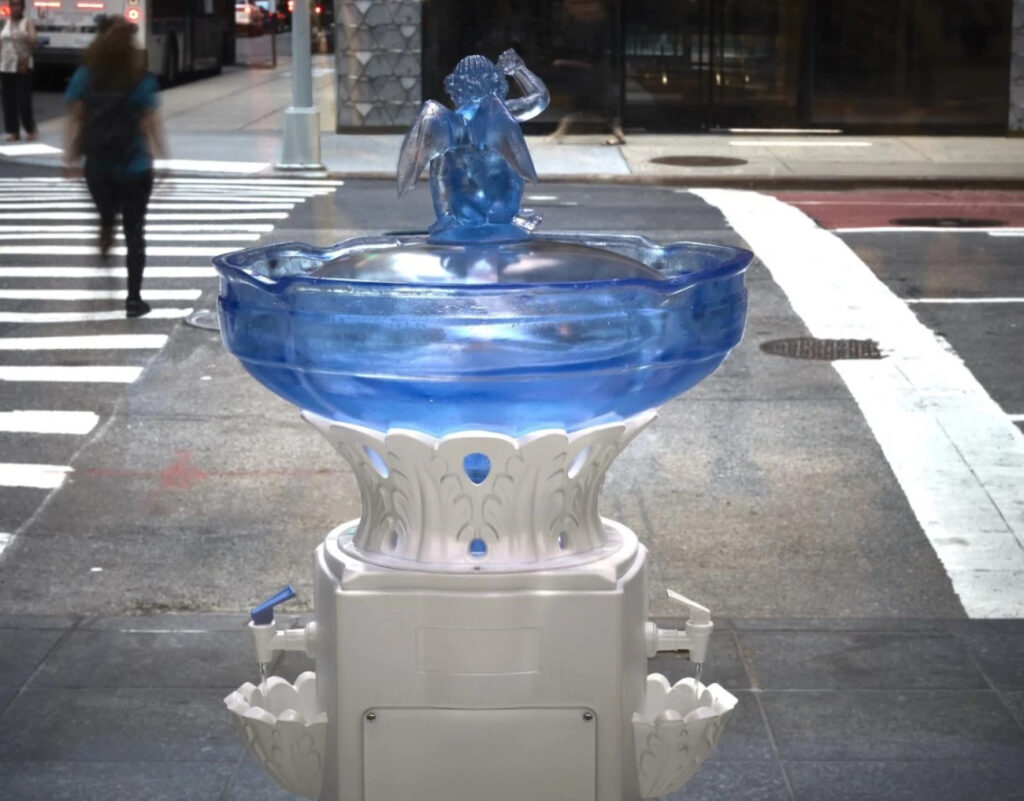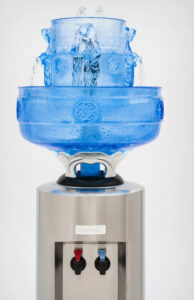

The workplace water cooler—once a symbol of break-time gossip and spontaneous conversation—has long lived under the backdrop of utilitarian design. Usually placed in anonymous corners, these appliances have rarely attracted attention for their aesthetic. That is, until Moreno Schweikle, a designer celebrated for his irreverent commentary on form and function, decided to radically rethink this office staple. Through his latest essence with Balenciaga’s ‘Art In Stores’ initiative, Schweikle transforms hydration into high culture, rendering water coolers as Baroque and Neoclassical fountains fit for a city square, not just a boutique.
Balenciaga’s Art In Stores: A New Gallery in Retail
To understand Schweikle’s reimagination, one must first understand the broader canvas upon which it is painted. Balenciaga’s Art In Stores is more than a visual merchandising campaign—it is a conceptual intervention. Overseen by creative director Demna, this initiative invites a select group of avant-garde artists to transform retail interiors into experiential installations. Among them: Anna-Sophie Berger’s fabric manipulations, Cayetano Ferrer’s archaeological deconstructions, Tobias Spichtig’s haunted forms, and now, Moreno Schweikle’s neoclassical aqueducts.
Unlike traditional gallery exhibitions, Art In Stores distributes the artworks across Balenciaga retail locations globally, challenging the idea of art as elite or isolated. In Schweikle’s hands, the water cooler becomes both functional object and sculptural provocation—a liquid totem that merges commerce, community, and culture.
Design as Dialogue: From Utility to Ornament
At the heart of Schweikle’s practice is an impulse to question default aesthetics. Why must functional objects be sterile? Why must offices be gray? Why must a water cooler look like a medical appliance? His Balenciaga fountains defy all such assumptions.
Schweikle takes cues from Baroque opulence and Neoclassical balance, manifesting in sculptural silhouettes that evoke European piazzas more than retail display. These aren’t just containers for water—they resemble municipal landmarks, with curving stone-like contours, elegant basins, and mythical detailing suggestive of cherubs, lions, or sirens. Each unit is visually elaborate, a stark contrast to the sterile plastic shells we’re accustomed to. Here, decoration is not antithetical to function, but instead elevates it.
This baroque absurdity evokes a humorous contrast: the idea of grabbing a sip of water beneath what appears to be a Roman fountain. It’s a moment of dissonance that turns the mundane into the sublime, and vice versa. Schweikle doesn’t just design—he satirizes modernity’s obsession with minimalism, asking us to reconsider what functionality should look like.
Retail as Ruin: Postmodern Parallels
Schweikle’s water fountains exist in the interstice between sculptural art and product design, but they also serve as postmodern ruins—a term borrowed from architecture critic Charles Jencks. Just as postmodern buildings often quote classical forms to comment on consumerism or nostalgia, Schweikle’s fountains quote antiquity to critique corporate architecture.
Their presence inside Balenciaga stores—which are themselves known for stripped-down, dystopic interiors—creates an ironic backdrop. Imagine a stark, brutalist showroom interrupted by a marble-like fountain, dripping elegance onto a concrete floor. In this environment, the water cooler becomes not just a node of interaction, but a rupture in aesthetic continuity.
This contradiction is precisely what fuels the Art In Stores initiative: a desire to unsettle the visual language of retail, where everything is usually calculated for maximum conversion. Instead, Schweikle’s fountain demands contemplation, even confusion. It disrupts the act of shopping and turns it into something theatrical, performative, even spiritual.
Function and Fiction: The Performance of Use
Beyond visual spectacle, Schweikle’s installation introduces an element of ritual to the act of hydration. Drawing water from a cooler that resembles a Roman bath or a Florentine public fountain creates an emotional dissonance. It elevates a biological necessity into a gesture of aesthetic encounter.
This elevation is not merely decorative—it reframes everyday gestures as ceremonial acts. Where we once had breakroom banality, Schweikle offers performative grace. Where hydration was mechanical, it is now symbolic—a baptism of brand and body.
One must also consider the irony of this placement. These sculptural pieces, while referencing public fountains meant for civic unity, are situated within luxury retail environments. They function as both critique and celebration—a designer joke about exclusivity, class, and shared space.
A Global Encounter: Art at the Point of Contact
The true genius of Schweikle’s intervention lies in its geographical pluralism. These water coolers are not confined to one flagship or art fair—they are scattered across the globe, from Seoul to London, from New York to Paris. In doing so, Schweikle universalizes a shared act—drinking water—but localizes its interpretation through sculptural nuance and contextual irony.
At each location, the fountain becomes a touchpoint for experience, creating community not just through conversation, but through spectacle. It’s a social sculpture in the truest sense—a term coined by Joseph Beuys—where the artwork facilitates participation, interaction, and the creation of meaning beyond its form.
Reimagining the Everyday Through Spectacle
Moreno Schweikle’s Balenciaga water fountains are not just eye-catching interventions; they are serious design provocations cloaked in humor, elegance, and irony. They ask: Why must the ordinary remain so? They argue for a world where the social function of space is honored by the aesthetic form of its objects.
In giving the humble water cooler its cultural due, Schweikle reframes the workplace break, not as a moment of escape, but as an opportunity for reverence, irony, and joy. In a fashion climate obsessed with exclusivity and spectacle, his fountains remind us that luxury can live in the most unexpected places—even in a cup of water.
No comments yet.








